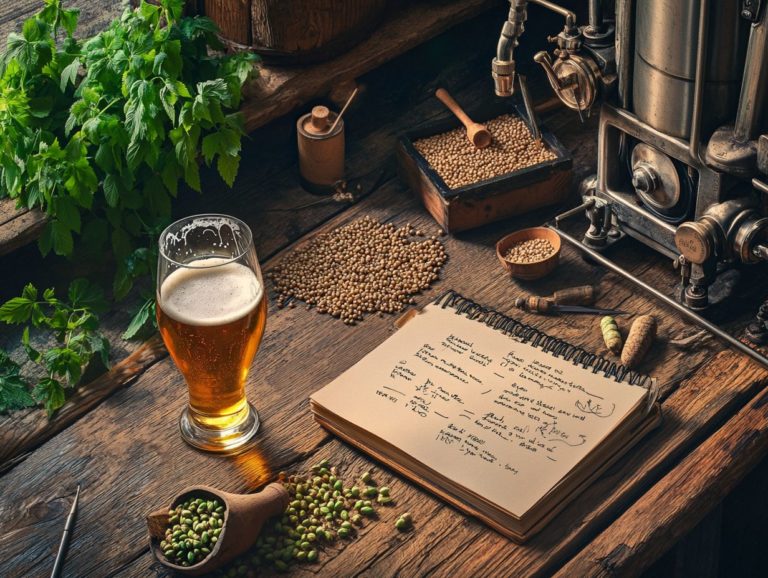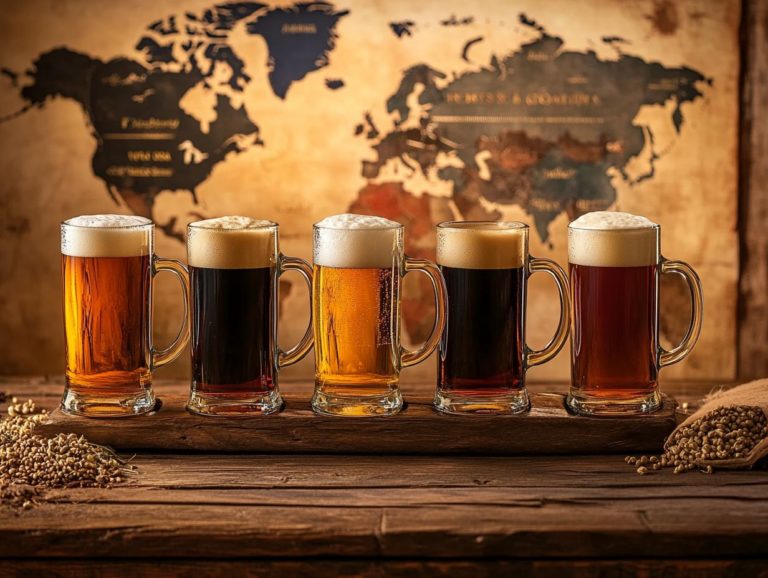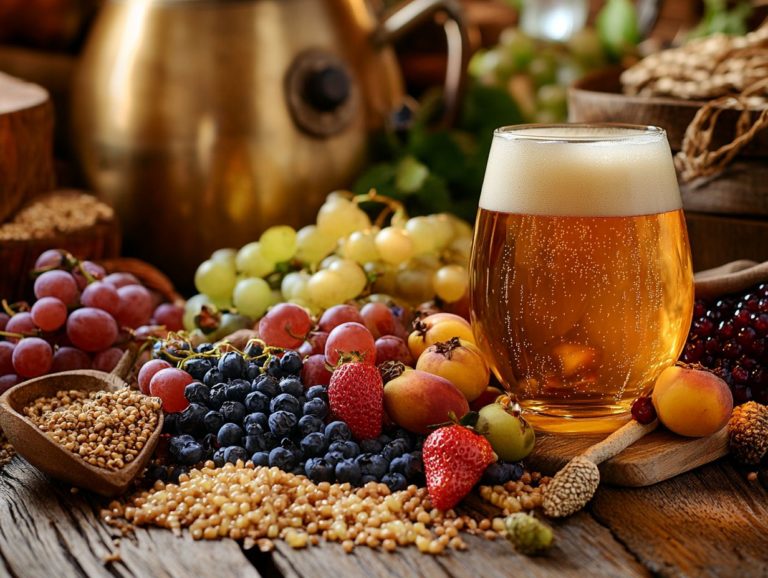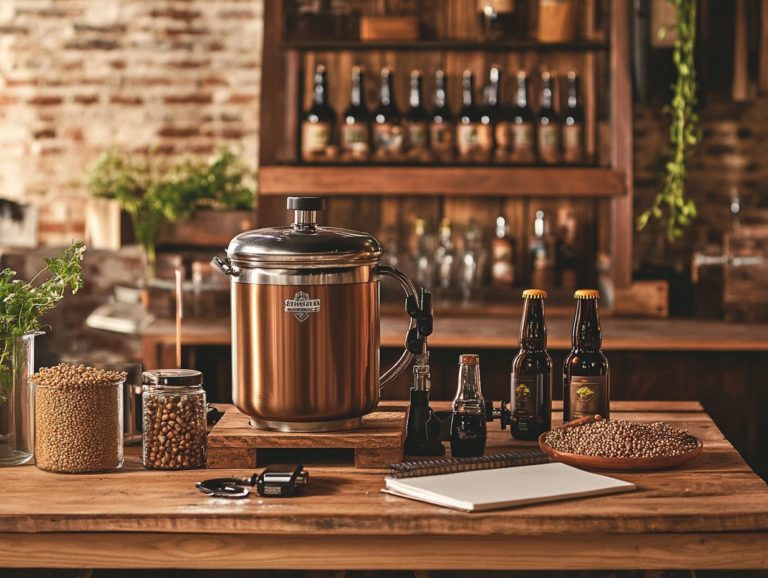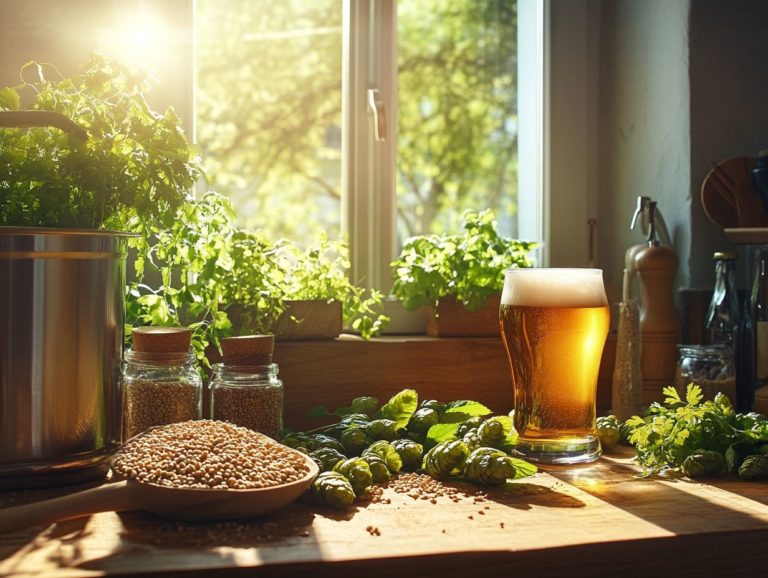How to Brew a Successful Batch of Amber Ale
Contents
- Brew Your Perfect Amber Ale
- Brewing Amber Ale: A Step-by-Step Guide
- 1. Steeping the Grains
- 2. Boiling the Wort
- 3. Adding Hops
- 4. Cooling and Transferring the Wort
- 5. Fermentation
- 6. Bottling or Kegging
- What are Some Tips for a Successful Batch of Amber Ale?
- 1. Sanitize all Equipment
- 2. Follow the Recipe Closely
- 3. Monitor Fermentation Temperature
- 4. Properly Carbonate the Beer
- What Food Pairings Go Well with Amber Ale?
- Frequently Asked Questions
- What ingredients do I need to brew a successful batch of Amber Ale?
- What equipment do I need to brew Amber Ale?
- How do I choose the right malt for my Amber Ale?
- What is the ideal water temperature for brewing Amber Ale?
- How long does it take to brew Amber Ale?
- What can I do to ensure a successful batch of Amber Ale?
Brew Your Perfect Amber Ale
Get ready to dive into the fun world of brewing Amber Ale! With its rich caramel flavors and perfectly balanced hop bitterness, this versatile beer style complements a wide variety of foods beautifully. Explore the essential ingredients, gain ingredient advice, follow the brewing process step-by-step, and absorb expert tips that can help you craft the perfect batch.
Uncover fantastic food pairings that will elevate your homemade Amber Ale to new heights. Immerse yourself in the art of brewing this delightful brew, whether you are into classic flavors or experimenting with seasonal beers!
Key Takeaways:
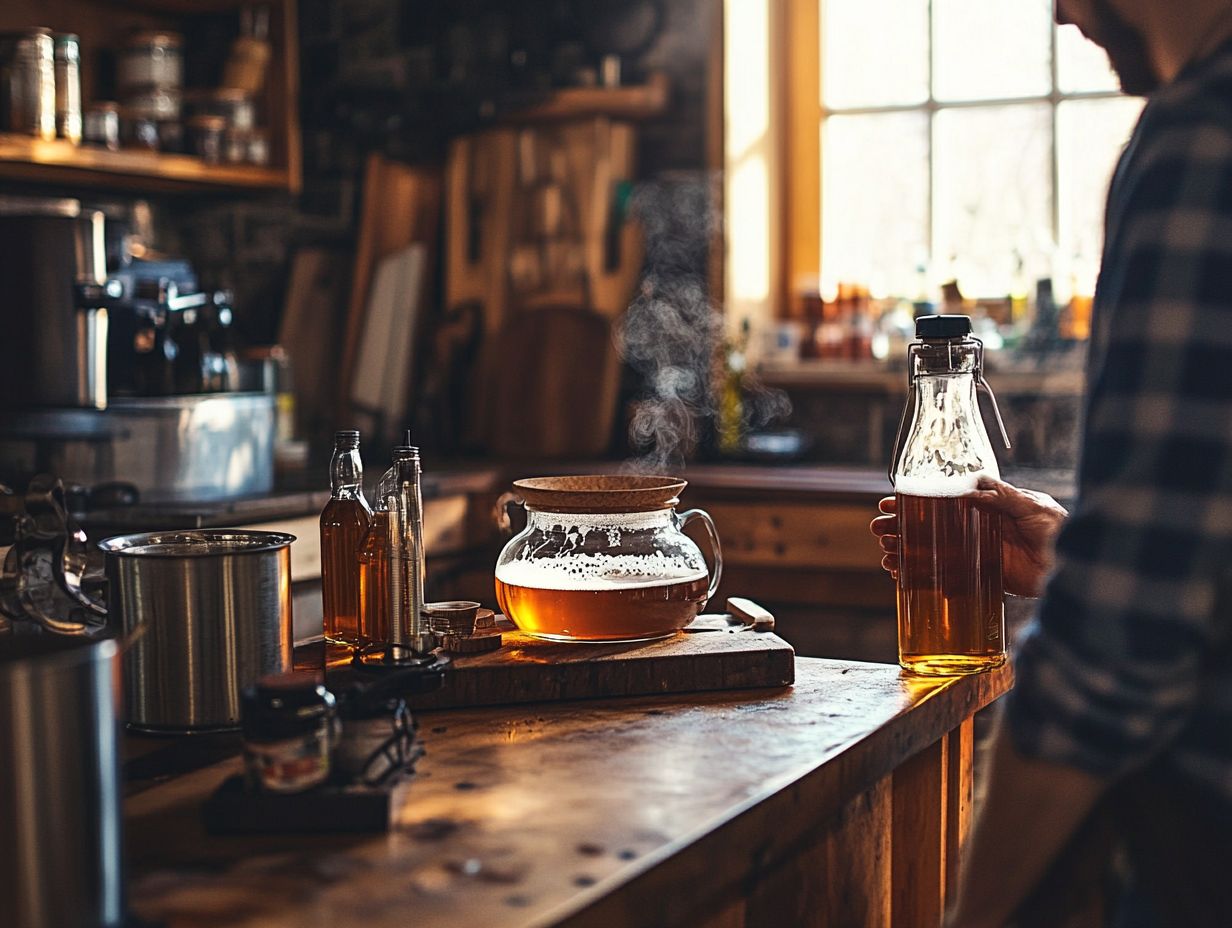
- Use quality ingredients such as malt extract, specialty grains, hops, yeast, and water to ensure a flavorful batch of Amber Ale. Experiment with different brewing ingredients to find your perfect malt-balanced character.
- Follow the brewing process carefully, including steeping grains, boiling wort, adding hops, cooling and transferring wort, fermenting, and bottling or kegging.
- Tips for success include sanitizing equipment, closely following the recipe, monitoring fermentation temperature, and properly carbonating the beer.
What Are the Ingredients Needed to Brew Amber Ale?
Brewing a truly delightful Amber Ale demands a careful selection of ingredients that harmonize to forge a balanced character, showcasing rich caramel flavors, enticing malt sweetness, and aromatic hop varieties.
The essential components malt extracts, specialty grains, hops, yeast, and water each play a pivotal role in the brewing process. By grasping the significance of these ingredients, you not only elevate the flavor profile but also enhance the overall drinkability and complexity of the beer, ensuring it becomes a cherished choice among beer aficionados, beer enthusiasts, and craft breweries alike.
1. Malt Extract
Malt extract serves as the backbone of Amber Ale, offering the essential sugars needed for fermentation while contributing to the beer’s signature rich malt flavor and sweetness. This foundational ingredient shapes not only the flavor but also the color of the final product.
Among the various malt types, caramel malt truly distinguishes itself with its remarkable ability to enhance the beer’s richness and impart a deep amber hue. Incorporating caramel malt into the brewing process adds delightful layers of flavor, infusing the brew with notes of toffee, caramel, and even subtle hints of dark fruit elements crucial for achieving the desired taste profile. This malt complexity contributes to the overall balanced character of the beer.
The interplay between different malt extracts can significantly influence the overall tasting experience. These malts work in harmony with hops and yeast, each contributing to a balanced and compelling profile. By carefully selecting malt extracts, brewers can refine the complexity of their Amber Ale, ensuring that each sip is both satisfying and bursting with flavor.
2. Specialty Grains
Specialty grains are essential in crafting Amber Ale, elevating the beer s flavor profile with an added layer of malt sweetness and complexity.
Grains like Crystal 80L, British crystal malt, or Munich malts impart rich caramel and toffee notes, striking a delightful balance between sweetness and bitterness. Utilizing these specialty grains not only enhances the depth of flavor but also transforms the mouthfeel, resulting in a smoother, more rounded drinking experience.
When brewing with these grains, employing techniques like steeping (soaking the grains in water to extract flavors) or mashing (mixing crushed grains with hot water to convert starches to sugars) at precise temperatures can greatly affect the extraction of sugars and flavors. By incorporating a diverse array of specialty grains, you can experiment with various textures and aromas, ultimately defining the uniqueness of your Amber Ale and distinguishing it from other beer styles.
3. Hops
Hops are essential in Amber Ale, serving not just to impart bitterness but also to elevate the aroma and add depth to the brew. The delicate balance of flavors becomes even more pronounced when you experiment with specific hop varieties like Citra, Amarillo, and American hops such as Equinox.
Citra hops introduce vibrant citrus notes, often reminiscent of grapefruit and lemon, that can beautifully counterbalance the malt sweetness typically found in Amber Ales. On the other hand, Amarillo hops contribute their unique character, boasting floral and tropical undertones that enrich the overall sensory experience.
The timing of hop additions is crucial during the brewing process. Early additions primarily focus on bitterness, while late additions just before fermentation amplify those aromatic qualities. This careful orchestration enables you to craft layers of flavor, ultimately resulting in a well-rounded and satisfying Amber Ale.
4. The Role of Yeast in Amber Ale
Yeast plays a crucial role in crafting Amber Ale, acting as the key to its unique flavors and aromas.
Among the myriad of strains at your disposal, California Ale Yeast, Lallemand s BRY-97, and Wyeast 1007 truly shine. They are lauded for their ability to create clean, balanced profiles that feature subtle fruity esters, elevating your brew to new heights. The yeast you select is not just an ingredient; it influences the entire fermentation process and the final alcohol content, ultimately shaping the mouthfeel and overall character of your beer.
Choosing the right yeast strain can unlock a spectrum of complex flavors, ranging from rich caramel to toasty notes, all while providing a sturdy backbone for your creation. However, navigating the brewing journey isn t without its challenges. Temperature control and the risk of off-flavors can rear their heads if fermentation isn’t managed with care. Master these factors to elevate your brewing game!
5. Water
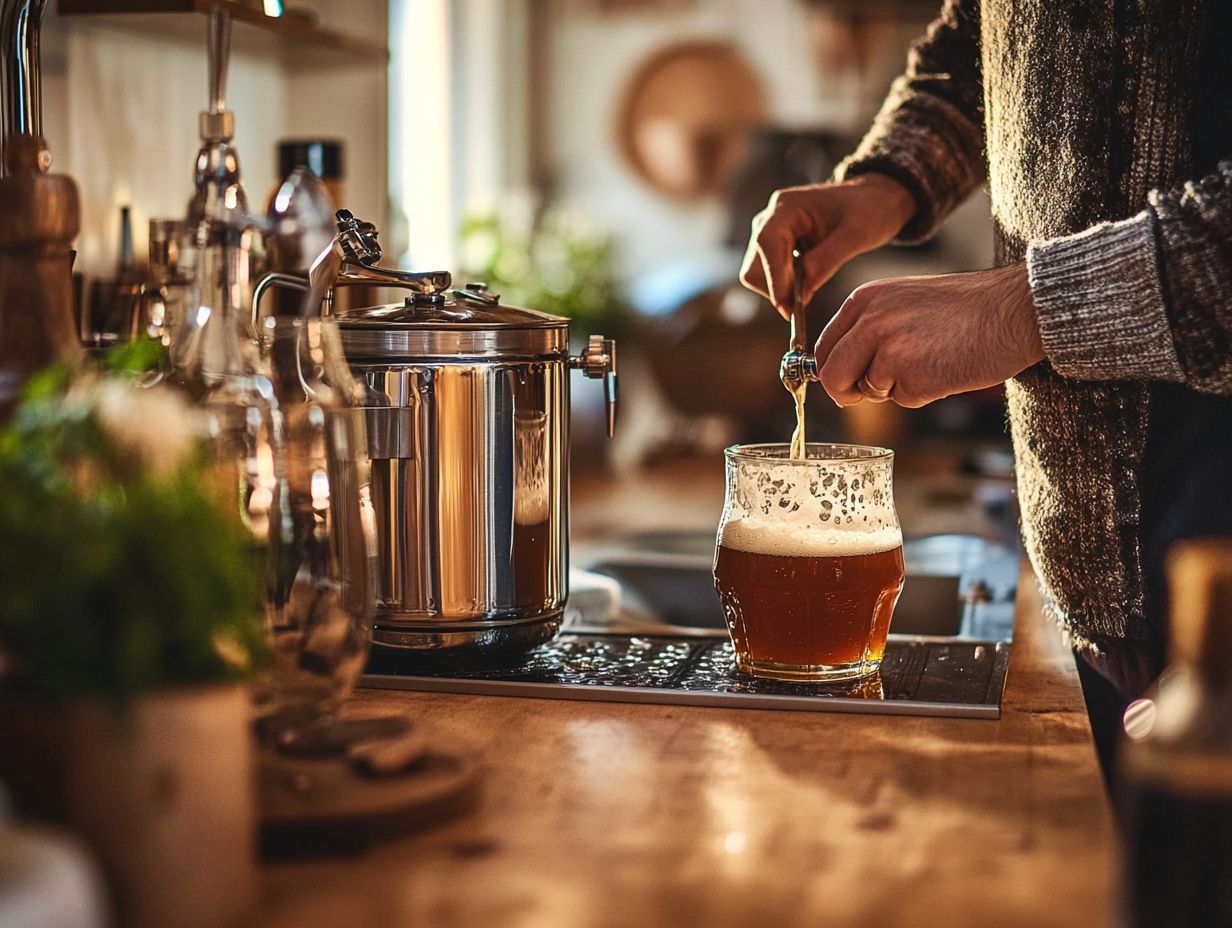
Water is often an overlooked ingredient in brewing Amber Ale, yet it plays a pivotal role in both the brewing process and the final character of the beer. Understanding aspects of water chemistry is crucial for achieving the desired results.
Water chemistry affects pH levels and mineral content. These factors are essential for effective extraction and fermentation. Typically, the ideal pH for brewing hovers between 5.2 and 5.6; this range is where optimal enzyme activity and hop utilization thrive. The balance of minerals, particularly calcium, magnesium, sulfate, and bicarbonate, can elevate the malt character and highlight the intricate flavors that define an exceptional Amber Ale.
To make the most of these elements, consider employing water treatment methods that adjust the mineral content with additives like gypsum or calcium chloride. By experimenting with different water profiles, you can unlock delightful variations, allowing you to craft an Amber Ale that truly showcases your brewing vision.
What is the Process for Brewing Amber Ale?
The process of brewing Amber Ale is a meticulous journey that invites you to engage in several key steps:
- Steeping grains
- Boiling the wort
- Adding hops
- Cooling
- Fermenting
- Bottling or kegging your brew
Each stage plays a vital role in shaping the overall flavor profile and quality of the beer, demanding your careful attention to detail and strict adherence to the recipe. Understanding these brewing methods is crucial for every brewer, whether you’re a novice or a seasoned beer enthusiast aiming to craft the perfect batch of Amber Ale. This knowledge is often shared in the vibrant brewing community, where brewers exchange valuable homebrewing tips.
Join brewing communities or forums to share your experiences and learn more!
Brewing Amber Ale: A Step-by-Step Guide
1. Steeping the Grains
Steeping the grains is the first crucial step in your Amber Ale brewing journey, allowing you to extract the rich flavors and sugars that are essential for fermentation. Mastery of these brewing techniques ensures that your beer maintains its malt complexity and balanced character.
This initial stage, often referred to as mashing, involves soaking the crushed grains in hot water, typically maintaining a temperature between 150 F and 160 F (65 C to 70 C).
At this sweet spot, the enzymes in the malt spring into action, converting starches into fermentable sugars. While the duration of the steeping process can vary, it s generally recommended to last around 30 to 60 minutes to achieve optimal extraction.
By carefully managing the temperature and time during the steeping process, you not only influence the concentration of sugars but also enhance the malt complexity and flavor profile, ultimately contributing to the distinctive character of your ale. This process is fundamental to many ale styles and can be adapted for various brewing experiments.
2. Boiling the Wort
Boiling the wort is an important moment in your brewing journey with Amber Ale. It s not just about cooking; it s your opportunity to sterilize the mixture and integrate those essential hops, which play a vital role in delivering both bitterness and aroma. This stage is an important part of brewing that has been refined over the years.
This process typically occurs at a vigorous heat of around 212 F (100 C), maintained for 60 to 90 minutes, depending on your recipe. The high temperature is your ally, ensuring that any unwanted microorganisms are eradicated while also helping to extract the vital oils from the hops.
The length of your boil can dramatically change your beer s character, so choose wisely! Longer boiling times will intensify bitterness and caramelize the malt sugars, while shorter boils will help retain more of those delightful hop aromas. To strike the perfect balance of bitterness, consider the timing of your hop additions; late additions will enhance aromatic qualities without overwhelming the overall flavor profile of your brew.
3. Adding Hops
Adding hops at specific intervals during the brewing process is key to elevating Amber Ale s flavor profile, aroma, and bitterness to new heights.
These intervals early, mid, and late additions each play a unique role in shaping the beer’s overall character. Early hop additions, generally introduced during the boiling phase, primarily contribute bitterness, laying the groundwork for the beer’s taste. Mid-boil additions enhance both bitterness and flavor, creating a well-balanced profile that invites appreciation. Understanding the timing of hop additions is essential in brewing science for achieving the desired hop flavors and aromas.
Late hop additions are essential for maximizing aroma, infusing the ale with vibrant floral, fruity, or piney notes that truly define its appeal. Selecting the right hop varieties becomes crucial; brewers carefully choose those that impart the desired characteristics and complement their brewing techniques, ensuring a seamless integration of flavors throughout the entire process.
4. Cooling and Transferring the Wort
Cooling and transferring the wort is an important step that follows the boiling process, laying the groundwork for successful fermentation. This essential procedure ensures that the wort reaches yeast pitch temperatures swiftly, which is crucial for preventing any off-flavors that may develop if the wort remains too hot for an extended period. This step is critical in maintaining the beer’s drinkability and overall quality.
As the wort cools, it not only creates an optimal environment for yeast activity but also facilitates the efficient removal of undesirable compounds that could compromise the flavor profile. You might consider employing common cooling methods, such as immersion chillers, which circulate cold water through a coiled tube within the wort, or counterflow chillers, where cooled water flows in the opposite direction to the wort.
Equally important are the techniques used during the transfer to the fermentation vessel. Minimizing air exposure while upholding hygiene standards can significantly influence the quality of your final product.
5. Fermentation
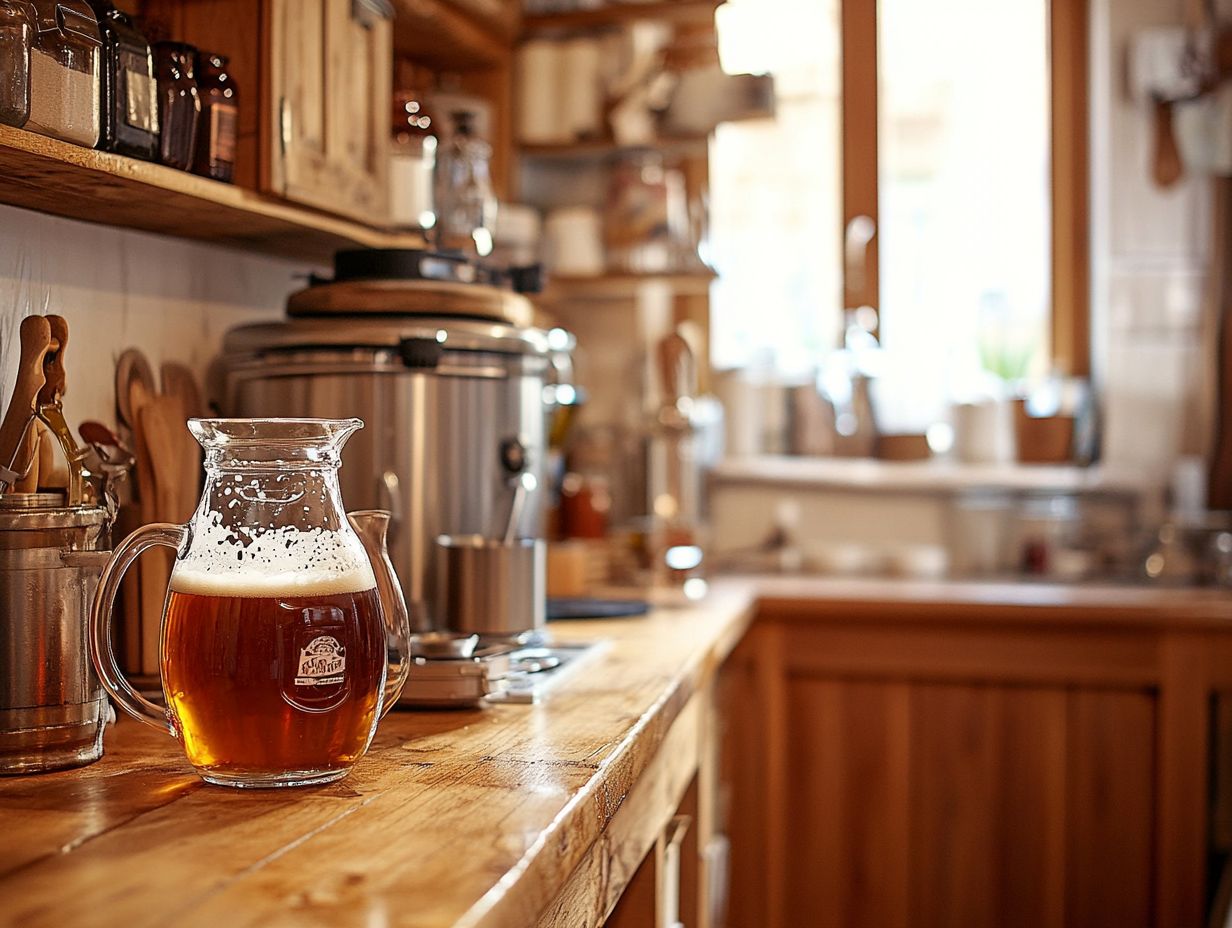
Fermentation is an important stage in brewing Amber Ale, where yeast transforms sugars into alcohol and carbonation. This process is vital for creating a great brew! Managing fermentation temperature is one of the key challenges that brewers face.
During this phase, your choice of yeast strains can significantly impact the brewing outcome. Different types of yeast can impart a range of flavor notes, influencing the overall profile of your ale. Each strain brings its own unique flair.
Temperature control during fermentation is critical. Warmer temperatures can enhance fruity esters, while cooler conditions typically yield a cleaner taste. Maintaining the optimal fermentation range is key to maximizing alcohol production and minimizing undesirable off-flavors.
You’ll likely encounter common challenges, such as stuck fermentation, which can arise from insufficient temperatures or less-than-ideal yeast health. To tackle these challenges, ensure you pitch the right amount of yeast. Also, monitor the specific gravity closely. This vigilant monitoring will help you achieve a seamless transition from sugar to beer.
6. Bottling or Kegging
Bottling or kegging marks the final step in your Amber Ale brewing journey. Achieving the right carbonation and packaging is crucial for preserving its rich flavor and freshness.
At this moment, meticulous attention to sanitation practices is non-negotiable. Ensure that all equipment, including bottles, caps, and kegs, is thoroughly cleaned and sanitized with a suitable solution to eliminate any lingering microbes that could spoil your hard work.
Regarding carbonation, you can choose between natural carbonation using priming sugar or forced carbonation with a CO2 tank. Both methods require careful measurements to achieve that perfect level of fizziness. Proper carbonation is essential for the desired mouthfeel and overall quality.
Once your brew is packed, the storage conditions become vital. Keeping the beer upright in a cool, dark environment can significantly extend its shelf life and maintain that distinctive taste you ve worked hard to create. This preparation stage is essential, as it directly influences the quality and enjoyment of the final product.
What are Some Tips for a Successful Batch of Amber Ale?
To craft a truly exceptional batch of Amber Ale, homebrewers should embrace essential tips that address common brewing challenges while enhancing the overall journey.
From meticulous sanitation practices to faithfully adhering to recipe formulations, every step plays a vital role in determining the quality of your final brew. By grasping and applying these homebrewing insights, you can elevate your brewing endeavors and create an amber ale that is not just enjoyable, but truly memorable.
1. Sanitize all Equipment
Sanitizing all your equipment is a key step in the brewing process, as it effectively prevents contamination that could spoil fermentation and ruin your batch.
For homebrewers, the importance of sanitation cannot be overstated; it serves as the foundation upon which quality beer is constructed. Using effective sanitizing agents such as Star San or a bleach solution will ensure that every piece of equipment, from fermenters to bottles, remains free from unwanted microorganisms.
Maintaining a clean environment not only protects against off-flavors and unexpected sourness but also enhances the overall safety of your brew. By adopting a thorough sanitization routine, you can confidently craft flavorful and refreshing beverages, knowing that your meticulous approach is key to producing a final product that exceeds your expectations.
2. Follow the Recipe Closely
Following the recipe closely is crucial for achieving the desired flavor profile of your Amber Ale. Each ingredient plays a vital role in crafting unique flavors and aromas.
Even small deviations can alter bitterness, sweetness, or mouthfeel. If you’re adventurous, adjusting the recipe to suit your taste can lead to delightful surprises.
Mastering the art of substituting or enhancing ingredients while preserving the overall harmony of your brew is an invaluable skill that can lead to the perfect pint, tailored just for you.
3. Monitor Fermentation Temperature
Monitoring fermentation temperature is crucial when brewing Amber Ale, as any fluctuations can lead to undesirable off-flavors and inconsistent outcomes. Maintaining optimal temperatures is essential for crafting the perfect flavor profiles and aromas.
Depending on the specific yeast strain you choose, varying temperatures can either enhance or hinder the fermentation process. Some yeast strains flourish at warmer temperatures, producing delightful fruity esters, while others prefer cooler conditions that yield a cleaner profile.
To create a stable fermentation environment, many brewers employ techniques such as temperature-controlled fermentation chambers, water baths, or even insulation and cooling jackets. These methods foster healthier yeast activity and elevate the overall quality of the brew.
4. Properly Carbonate the Beer
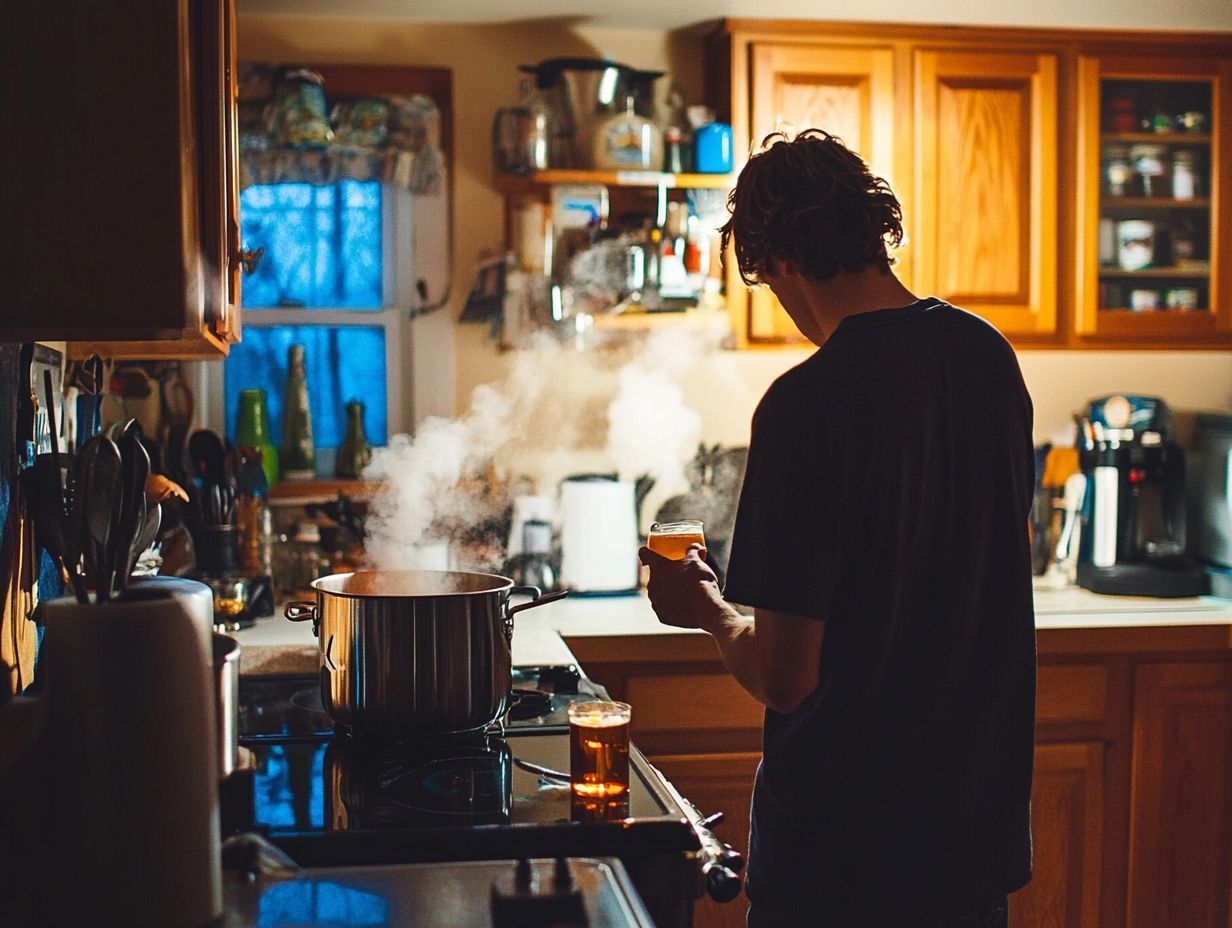
Properly carbonating your beer is essential for enhancing the mouthfeel and overall enjoyment of Amber Ale. Achieving just the right level of carbonation can bring forth the beer’s aromas and flavors while adding that delightful touch of effervescence.
One effective method is natural carbonation, which involves fermenting the beer in a sealed vessel with added sugar. This approach allows the yeast to produce carbon dioxide naturally, resulting in a smoother mouthfeel.
Alternatively, forced carbonation is a quicker method where CO2 is directly injected into the beer, often preferred in kegging scenarios. While natural carbonation may take longer, it imparts wonderful subtleties to the beer’s taste.
For those who enjoy kegging, using a CO2 tank provides precise control over carbonation levels. However, if you re bottling, you might appreciate the rustic charm of natural methods.
What Food Pairings Go Well with Amber Ale?
Amber Ale presents a rich flavor profile that serves as an exceptional companion for a wide array of dishes. This beer style is known for its malt-balanced character and moderate alcohol content, making it versatile in culinary settings.
Its malt-balanced character and subtle caramel notes harmonize beautifully with many classic flavors found in food. Pair it with grilled meats or artisanal cheeses for the best experience.
Whether you re indulging in grilled meats or savoring artisanal cheeses, mastering food pairings can elevate both the dish and the beer. Can you imagine celebrating the very essence of beer culture?
Amber Ale, especially American Amber, is celebrated for its versatility and balanced character. Popular examples include Newcastle Brown Ale, Fat Tire Amber Ale, Alaskan Amber, Red Seal Ale, and Bells Amber Ale.
Frequently Asked Questions
What ingredients do I need to brew a successful batch of Amber Ale?
To brew a successful batch of Amber Ale, you will need water, malted barley, hops, yeast, and extra flavoring ingredients like spices or fruit. American hops are often preferred for their distinctive bitterness and aroma.
It is important to use high-quality ingredients for the best results.
What equipment do I need to brew Amber Ale?
You will need a large pot or kettle, a fermenter, a thermometer, an airlock and stopper, a siphon and tubing, bottles or a keg, and a bottle capper or kegging system.
Having a tool to check how strong your beer is can also be helpful. For more advanced setups, consider using equipment like the Spike Solo.
How do I choose the right malt for my Amber Ale?
The type of malt you choose will greatly affect the flavor and color of your Amber Ale. Generally, Amber Ales use a combination of pale malt and caramel malt to achieve a rich, malty taste and a deep amber color.
You can also experiment with different types of malt, such as Maris Otter, to create your own unique flavor profile.
What is the ideal water temperature for brewing Amber Ale?
The ideal water temperature for brewing Amber Ale is around 150-155 F (65-68 C). This range allows the enzymes in the malt to convert starches into sugars, which will later be fermented by the yeast.
This understanding is fundamental in brewing science for achieving the best results.
How long does it take to brew Amber Ale?
Brewing Amber Ale usually takes about 4 to 6 weeks! This time includes fermentation, carbonation, and letting your beer condition in bottles or a keg.
However, the actual brewing process can be completed in just a few hours. Engaging in homebrew recipes and brewing adventures can make this time both enjoyable and educational.
What can I do to ensure a successful batch of Amber Ale?
To ensure a successful batch of Amber Ale, pay attention to cleanliness and sanitation. Be sure to follow the recipe and instructions carefully while monitoring the fermentation process.
It s also helpful to keep detailed notes and adjust your recipe for future batches based on your results. Participating in a beer competition, like the National Homebrew Competition, can provide valuable feedback and insights!

